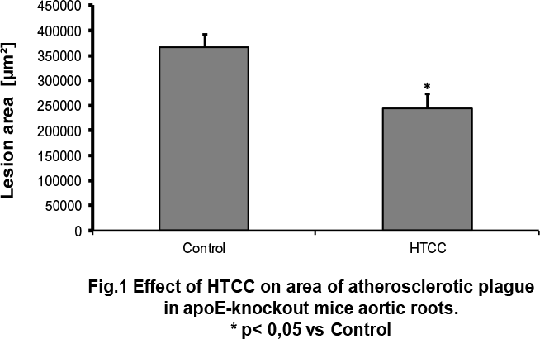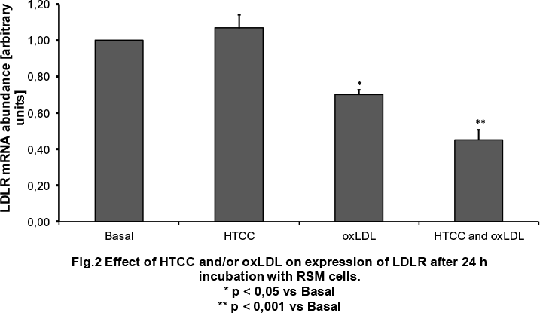Print version
Search Pub Med
Effect Of Newly Synthesized Cationically Modified Chitosan On Progression Of Atherosclerosis And Expression Of Lipid Metabolism Genes In The ApoE-knockout Mice Chitosan is a natural polysaccharide obtained from chitin, building component of the crustacean exoskeleton (1). Cationically modified chitosan, N-(2-hydroxypropyl)- 3-trimethylammonium chitosan chloride (HTCC) has been synthetized by us recently by covalent attachment of glycidyltrimethylammonium chloride (GTMAC) with the degree of substitution 63.6% (2). Modified polymer is characterized by higher bioavailability than native chitosan, due to its better solubility in physiological pH (1). The aim of the study was to investigate the possible impact of cationic chitosan on progression of atherosclerosis and on lipid metabolism using an experimental model of atherosclerosis - apoE-knockout mice. HTCC was administered orally with the diet at the dose of 300 mg/kg b.w./day for 18 weeks. Mice euthanasia was performed by inhalation of carbon dioxide. Using the computerized system of morphological analysis of the atherosclerotic lesion area in the aortic root (by cross-section method with oil red O staining of lipids in atherosclerotic plaques) we found that HTCC significantly reduced progression of atherosclerotic lesions (by 33% in comparison to the control without HTCC in diet). Results are shown in fig. 1 (mean ± SEM, n=10 in HTCC group and n=14 in control). Unpaired Student’s T-test indicates probability at the level of p=0,006. In mice treated with HTCC a significant increase (a mean of 5%, p=0,02) of the body weight was observed as compared to the control. In addition, using Real-Time PCR reaction we were able to demonstrate that HTCC significantly increased the level of mRNA for LDLR (low density lipoprotein receptor) in the liver (p=0,0007, control group: n=3, HTCC group: n=3) and significantly raised the level of mRNA of the liver HMG-CoAR (3-hydroxy-3-methyl-glutaryl-CoA reductase) (p=0,047, control group: n=3, HTCC group: n=4). On the other hand, HTCC significantly lowered the level of mRNA of HMG-CoAR in the aorta (p=0,039, HTCC group: n=3, control group: n=3). In studies in vitro, rat smooth muscle cells line (RSM) pretreated with HTCC and oxLDL (oxidized low density lipoproteins) for 24 hours, significantly decreased the level of mRNA for LDLR as compared to the control group (fig. 2; Tukey’s RIR test, p=0,0002; results from Real-Time PCR reaction, n=5 in control group, HTCC group: n=3, oxLDL group: n=3, oxLDL and HTCC group: n=4). As found for oxLDL, there is a significant decrease in LDLR expression (Tukey’s RIR test, p= 0,006; comparing to the control) but this effect is weaker than observed for oxLDL and HTCC combined together. Our results indicate that HTCC - newly synthesized cationic chitosan - may be useful anti-atherosclerotic agent.
(1) Stefan J et al. (2014). J Physiol Pharmacol 65: 341-347. (2) Kamiński K et al. (2010). J Med Chem 53: 4141–4147.
|



